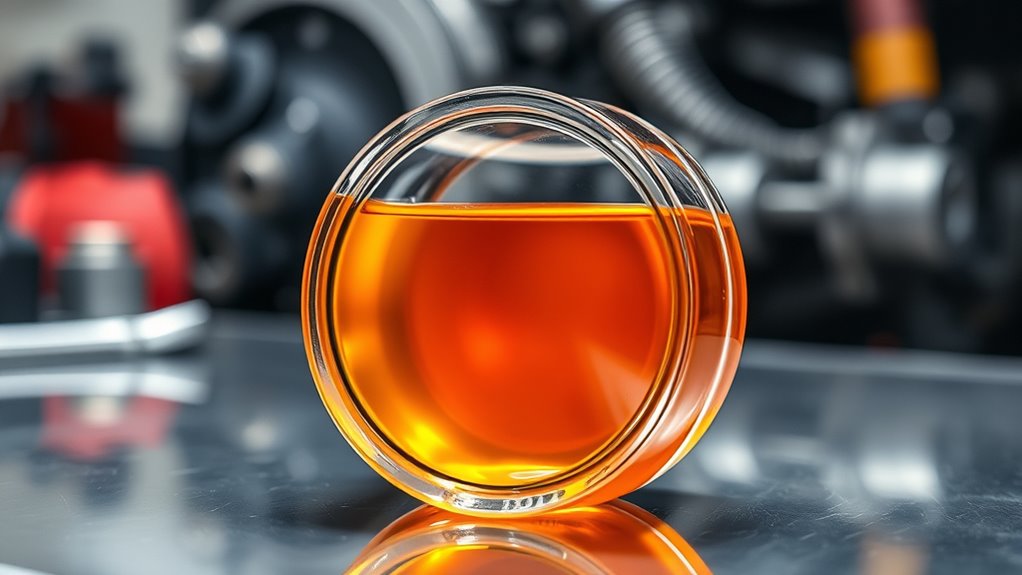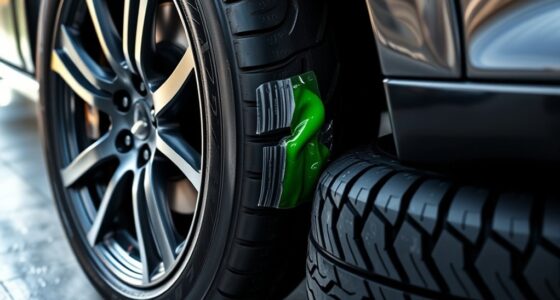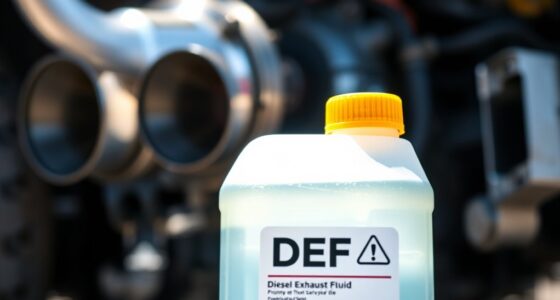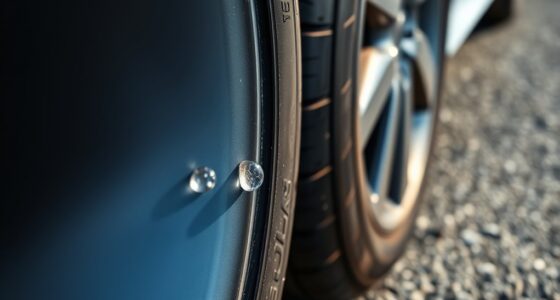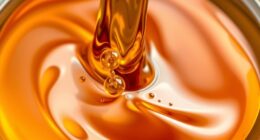DOT brake fluid is a hydraulic liquid used to transfer force from your brake pedal to the brake components. There are different types, like DOT 3, DOT 4, DOT 5, each with unique properties such as boiling points and moisture absorption. Using the correct brake fluid guarantees safety and peak performance. Mixing incompatible types can cause damage. Keep in mind that proper maintenance and choosing the right fluid are key—continue to explore to learn more about keeping your brakes in top shape.
Key Takeaways
- DOT brake fluids are classified by standards (DOT 3, DOT 4, DOT 5) based on performance and chemical composition.
- DOT 3 and DOT 4 are glycol-based, while DOT 5 is silicone-based, affecting compatibility and moisture absorption.
- Proper selection of DOT brake fluid ensures optimal braking performance and prevents damage to the braking system.
- Regular inspection and replacement of brake fluid help maintain safety and prevent brake fade caused by moisture absorption.
- Mixing different DOT brake fluids can cause chemical reactions and impair braking effectiveness.

Ever wondered how your vehicle’s braking system stays reliable and responsive? The key lies in the brake fluid that transfers force from your brake pedal to the brake pads, enabling you to stop safely. But not all brake fluids are the same. There are different brake fluid types, each designed to meet specific performance standards and compatibility requirements. Understanding these types helps you choose the right fluid and keep your braking system in top shape. DOT 3, DOT 4, and DOT 5 are the most common classifications, with DOT 3 and DOT 4 being glycol-based fluids and DOT 5 made from silicone. Each type has unique properties, such as boiling points and moisture absorption rates, which influence their suitability for various driving conditions and vehicle specifications.
Maintaining your brake fluid is vital for vehicle safety and performance. Over time, brake fluid absorbs moisture from the air, which can lower its boiling point and lead to brake fade or failure under heavy use. That’s why regular maintenance tips include checking your brake fluid level and condition. You should inspect the fluid reservoir periodically, ensuring the fluid is at the proper level and appears clear or slightly amber. If it looks dark or contaminated, it’s time to flush and replace it. Many vehicle manufacturers recommend changing brake fluid every two years, but always consult your owner’s manual for specific guidance.
Regularly check and replace brake fluid to ensure safety and optimal vehicle performance.
Using the correct brake fluid type for your vehicle is essential. Mixing different types can cause chemical reactions that compromise braking performance. For example, DOT 3 and DOT 4 fluids are compatible with each other, but DOT 5 silicone-based fluid should never be mixed with glycol-based types. When replacing brake fluid, always follow the manufacturer’s recommendations and use the specified DOT grade. This guarantees peak performance and prevents damage to seals and components in your braking system.
Another maintenance tip is to have your brake system inspected by a professional regularly. They can check for leaks, worn pads, and other issues that might affect braking efficiency. When topping off brake fluid, do so carefully, avoiding spills and overfilling, which can also cause problems. Keep in mind that brake fluid is hygroscopic, meaning it attracts moisture, so sealed containers and proper storage are important to maintain its effectiveness.
Frequently Asked Questions
How Often Should I Change My DOT Brake Fluid?
You should change your DOT brake fluid every 1 to 2 years, or according to your vehicle’s maintenance schedule. Different brake fluid types, like DOT 3, DOT 4, and DOT 5, have varying lifespans. Regularly replacing the fluid prevents moisture buildup and corrosion, ensuring ideal brake performance. Check your owner’s manual for specific recommendations, and don’t delay fluid changes to keep your braking system safe and reliable.
Can I Mix Different DOT Brake Fluid Types?
You shouldn’t mix different DOT brake fluid types because of brake fluid compatibility issues. Mixing fluids can lead to fluid mixing risks, which may reduce braking performance or damage your brake system. Always check your vehicle’s owner manual to confirm you use the correct DOT brake fluid type. If you’re unsure, it’s safest to flush the old fluid and replace it with the proper type to maintain ideal brake function.
What Are the Signs of Contaminated Brake Fluid?
You’ll notice brake fluid contamination when it looks dark or cloudy, indicating fluid degradation. If your brake pedal feels spongy or sinks slowly, contamination could be the cause. You might also hear squealing or experience reduced braking performance. Regularly checking your brake fluid helps catch signs of fluid degradation early, preventing further damage. If you suspect contamination, it’s best to flush and replace the fluid promptly to maintain braking efficiency.
Does DOT Brake Fluid Affect Vehicle Braking Performance?
Your vehicle’s braking performance hinges on DOT brake fluid, which is essential for safe stopping. If the brake fluid’s properties deteriorate, it can cause your brakes to feel spongy or unresponsive—threatening vehicle safety. Properly maintained brake fluid ensures ideal pressure transfer, preventing dangerous delays or failures. Ignoring these signs risks compromising your control, making it critical to check and replace your brake fluid regularly for peak performance and maximum safety.
Is DOT Brake Fluid Environmentally Friendly?
DOT brake fluid isn’t very environmentally friendly because it can be toxic and pollute water sources if disposed of improperly. You can minimize its environmental impact by following proper recycling methods, such as taking used fluid to authorized disposal centers. Always avoid pouring brake fluid down drains or onto the ground, and check local regulations to guarantee safe disposal. Responsible handling helps protect the environment from harmful chemicals.
Conclusion
Think of DOT brake fluid as the heartbeat of your car’s braking system, keeping everything flowing smoothly and safely. Just like a steady pulse keeps a heartbeat strong, the right brake fluid guarantees your brakes respond when you need them most. Keep it topped up and in good condition, so your vehicle’s safety rhythm stays consistent. When you care for it, your car’s braking dance remains graceful and reliable, ready to protect you at a moment’s notice.
